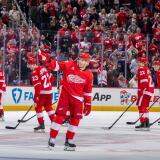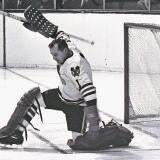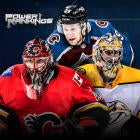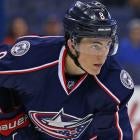Pacific Division: Team-by-team preview
The race for the Pacific Division crown could be an All-California battle in 2013-14.

More NHL offseason: Rumors | Top 50 Free Agents | Buyout Tracker | Trades | Transactions
The Pacific is awfully intriguing heading into the season. Several of the teams within it have a case to make a run at the division title this year and the race to get there could be tight all season.
Los Angeles has the 2012 Stanley Cup and a trip to the 2013 Western Conference Final still close in the rearview mirror, while Anaheim is coming off a stellar regular-season performance. Meanwhile, Vancouver may be able to avoid the drama that consumed the Canucks last season and Phoenix appears ready to bounce back from what turned out to be a forgettable 2013.
The San Jose Sharks and Edmonton Oilers appear to be teams on opposite ends of the spectrum in terms of how they’re constructed. The Sharks are still hoping to squeeze as much as they can out of a veteran lineup that has struggled in postseason play, while the Oilers hope to take yet another step forward with its remarkable core of youngsters.
Then there’s the Calgary Flames, and… well. It might be a rough year.
Most important player: Jonathan Quick. The team in front of him is largely unchanged from a season ago, which is why Quick needs to show a bit better than he did when his numbers took a nosedive in 2013. Though he seemed to regain the magic in the postseason, Quick needs to be sharp throughout the regular season. He doesn’t have to be as good as he was in 2011-12 when he posted a career-best .929 save percentage and 1.95 goals-against average, but he has to put 2013’s regular-season showing behind him entering this tough division.
X-factor: Jeff Carter. To expect Jeff Carter to sustain a 19.5 shooting percentage this year after doing so in 2013 to the tune of 26 goals, you’d be nuts. That said, Carter has established himself as an elite goal scorer and certainly has 50-goal potential in him at 28 years of age. If he gets hot, the Kings are going to be tough to slow down.
The Stanley Cup hangover probably shouldn’t have affected the Kings as much after not starting the season until January, but it may have. The expectations were high for the champs coming into the season and it took them a while to turn things up, especially Jonathan Quick who was shaky for parts of last season.
That said, LA still looks like it could be one of the West’s best. With the Stanley Cup core intact, the Kings should continue to be a major threat. Carter is coming off one of the best seasons of his strong career and should continue to be a regular scoring threat. Combine him with the terrific Anze Kopitar, who led the Kings with 42 points last season, the bruising Dustin Brown and Mike Richards and the Kings look pretty healthy in their top six. That could also end up including talented youngster Tyler Toffoli at some point, as he could be looked to for more production after a strong showing in 10 regular-season and 12 postseason contests.
Defensively, Drew Doughty is further cementing himself as one of the game’s best all-around defensemen. The emergence of Slava Voynov last season also helps the Kings establish some scoring depth from the back end. The Kings will have to weather the loss of Rob Scuderi, who ate a lot of minutes last season, but Robyn Regehr should help supply some solid veteran presence on the backend. Additionally, Alec Martinez and Jake Muzzin should be ready to step into bigger roles for the team this season.
Then it all comes back to Quick, who when at his best, is among the best goaltenders in the world. If he’s on his game, the Kings are a really good bet to win the division and push for another Stanley Cup.
| Standings with last season's records | ||||
| Team | Wins | Losses | OTL | Points |
| 1. Ducks | 30 | 12 | 6 | 66 |
| T-2. Kings | 27 | 16 | 5 | 59 |
| T-2. Canucks | 26 | 15 | 7 | 59 |
| 4. Sharks | 25 | 16 | 7 | 57 |
| 5. Coyotes | 21 | 18 | 9 | 51 |
| 6. Oilers | 19 | 22 | 7 | 45 |
| 7. Flames | 19 | 25 | 4 | 42 |
Most important player: Ryan Getzlaf. After a big bounce back from a lackluster (by Getzlaf standards) 2011-12, Getzlaf will likely be expected to shoulder a heavy load offensively along with Corey Perry. That’s especially true with the departure of Bobby Ryan. Getzlaf is the leader of this team and will need yet another strong season to keep the Ducks in the hunt.
X-factor: Jonas Hiller/Viktor Fasth. Splitting time between these two netminders, the Ducks put together one of the best records in the league. Fasth’s success came unexpectedly so it will be interesting to see if he will be able to sustain what he accomplished while splitting duties with Hiller last season. As a 30-year-old first-time NHLer, Fasth posted a .921 save percentage and 2.18 goals-against average in 25 appearances. It’s always interesting to see how the tandem dynamic works and whether or not one of these guys will take on more of a No. 1 role. That will be a storyline worth watching all year.
The Ducks, under the full-year stewardship of head coach Bruce Boudreau, engineered a rather remarkable turnaround that took the team from 13th in the West in 2011-12 to second in 2013. A lot of things went right, except for that early exit from the Stanley Cup Playoffs at the hands of the Detroit Red Wings.
Anaheim had good scoring depth, strong goaltending and some remarkable performances put in by a veteran defensive crop last season. This season could prove a bit more challenging, however.
The loss of Bobby Ryan was necessary to manage the cap, but his near-guaranteed 30-plus goals a season is difficult to replace. Jakob Silfverberg, who came over in the trade from Ottawa for Ryan showed promise last season and could help fill some of that void, but more than likely, Ryan will have to be replaced by committee. Kyle Palmieri took a big step forward and could support scoring depth, as could Emerson Etem over the course of the season. Seasoned veterans like Saku Koivu and Teemu Selanne should also have strong roles offensively.
Defensively, the Ducks will have to weather the storm early without Sheldon Souray, who is expected to miss the first two months of the season after tearing a ligament in his wrist. Meanwhile, Francois Beauchemin is still recovering from knee surgery over the offseason. He was Anaheim’s best defenseman and one of the league’s best over the truncated season. If there’s any lingering effects on either injury, that could change things drastically for the Ducks. There should be plenty expected from Luca Sbisa and Cam Fowler as well as the two young defensemen are now established veterans.
The two-headed monster in the net has the potential to be the equalizer if the Ducks D is depleted for any amount of time above what is expected. Hiller and Fasth both played solidly in net and give their team a chance to win just about every night.
This team has a strong veteran presence and Boudreau really got the most out of his group last season. If he can do it again, the Ducks should be a force.
 3. San Jose Sharks
3. San Jose Sharks
Most important player: Logan Couture. The torch may be in the process of being passed still, but this is Couture’s team. After another remarkable season, his third full-time campaign with the Sharks, Couture’s impact cannot be understated. He led the Sharks with 21 goals last season, while absorbing some tough matchups. At just 24, Couture has taken some of the burden away from the aging Joe Thornton and Patrick Marleau and makes the Sharks top six forwards as formidable as anybody’s.
X-factor: Brent Burns. After being converted from defense to right wing mid-season in 2013, Burns and the Sharks saw their fortunes turn. He’ll remain up front this season and give the Sharks an imposing power forward who can play at both ends of the ice and bring some extra scoring pop. In 23 games after making the move, the only forward that scored more goals than Burns’ nine was Couture. Given that small sample, it’s hard to know just how big of an impact Burns can have at the position over the course of next season, but if he’s anywhere close, the Sharks are a more dangerous offensive team.
It was almost a tale of two seasons for the Sharks. As they started to dwindle away near the trade deadline, it looked like San Jose might be sellers, but all general manager Doug Wilson did was make shrewd moves, while head coach Todd McLellan made effective adjustments. The Sharks righted the ship, made the playoffs and even won a playoff series.
Even with the move of Burns to forward, the Sharks have a pretty solid defense led by salty veteran Dan Boyle, who still provides a strong offensive presence from the back end, and Marc-Edouard Vlasic, who often absorbs the toughest defensive matchups. Brad Stuart and Justin Braun also established important roles last season and should continue to contribute a lot defensively.
At forward, the Sharks have had a great core for years led by Joe Thornton and Patrick Marleau. With Couture continuing to grow into one of the better producers in the league, Joe Pavelski providing a solid veteran presence and Burns adding size up front, there’s reason to expect productivity to grow from last season.
One of the biggest factors in what happens to the Sharks this season will be the play of Antti Niemi in net. The Finnish goaltender put together a career year, which made him a finalist for the Vezina. It wouldn’t be terribly stunning to see his numbers take a dip as he vastly out-performed his career averages, but if he maintains even a similar level of play, the Sharks are a dangerous hockey club.
Most important player: Roberto Luongo. After the soap opera of last season played out as it did, with the shocking conclusion that Cory Schneider was the goalie traded away from Vancouver, it is valid to wonder how it will affect Luongo. If he’s moved on, he’s still a strong goaltender and will contribute to anything the Canucks accomplish. If he’s still unhappy in Vancouver and Luongo’s numbers look like they did last season, the Nucks are going to have a really tough time.

X-factor:
John Tortorella. The Canucks' new head coach reportedly wore out his welcome with players in New York. He inherits a team that has a solid core of veteran stars. He has the task of getting the most he can out of Luongo and will have to ensure his defensive-minded strategies find a way to gel with top offensive talents Daniel and Henrik Sedin. Tortorella has had plenty of success in this league, but it's fair to wonder how his style will mesh with his new team. It will be a big factor in how Vancouver performs this season.
The Vancouver Canucks were a bit of an enigma last year. Shrouded by the Roberto Luongo saga at times, the Canucks still managed to win the Northwest (probably because it was the Northwest). Truth be told, however, Vancouver was a very average team and its first-round sweep at the hands of the Sharks was far from surprising.
Now the net belongs solely to Luongo, with the inexperienced Eddie Lack backing up. There’s really not much of a safety net if things go south at the goaltending position.
The Canucks do boast a sold defensive corps with a lot of veteran experience. Kevin Bieksa, Alexander Edler, Dan Hamhuis and Jason Garrison make up a good group for Tortorella to lean on and play his brand of hockey.
At forward, the Canucks will need more scoring than they got last season. Vancouver was 19th in the league with an average of 2.54 goals-per-game. Getting Ryan Kesler back for a full season should help support the always steady production of the Sedin twins, but there is valid concern when it comes to scoring depth. Jannik Hansen, Alex Burrows and Zack Kassian are among the guys that will be looked to for more scoring, but 22-year-old Jordan Schroeder could be another source of secondary production.
This is a team that always seems impossible to count out after years of solid regular-season performances and deep playoff runs. The clock is ticking, however, and the window of competitiveness is closing before this team needs more youth injected into its lineup. If Tortorella can push the right buttons, this club should be able to make an impact in the new Pacific and look like a likely playoff team.
Most important player: Mike Smith. Coyotes fans shouldn’t expect a season as great as Smith’s performance in 2011-12, which he was also unable to follow up last season. Smith was an average starting goaltender last year and if the Coyotes hope to make the playoffs this year, he’ll have to be better than that, especially now that he’s being paid like a top-end No. 1.
X-factor: Mike Ribeiro. The big offseason acquisition for the Coyotes will have to bring productivity with him to the desert. Ribiero averaged better than a point-per-game last season with the Capitals, but the chances of him reproducing such a performance in Phoenix are slim at best. His ability to produce should make the Coyotes better, however. It's just hard to imagine it will be enough to live up to his four-year $22 million contract.
The Coyotes ownership saga was the elephant in the room over the last several seasons, but with that resolved, the focus needs only to be on hockey for Coyotes players and management. There’s no telling how much, if at all, that weighed on the team, especially as things looked dire in recent seasons.
With everyone knowing where they’ll be for the foreseeable future, this team should be able to move past a disappointing 2013, which saw the Coyotes finish four points back of the last playoff spot in the West a year after reaching the Western Conference Final.
While Mike Smith’s upcoming season is hard to get a good read on, he’ll have a solid defensive corps in front of him led by potential Norris Trophy candidate Oliver Ekman-Larsson. The 22-year-old logs major minutes against top lines and has enough offense in his game to contribute at the other end as well. He's truly one of the great two-way talents in the league.
There’s also Keith Yandle, who led the team in scoring last season with 30 points. Since 2009-10, only two defensemen in the NHL had more points than Yandle – Dan Boyle and Duncan Keith. Having both an elite defender like OEL and elite puck-mover like Yandle would make most teams jealous, especially when you add in a guy like Zbynek Michalek as another strong veteran defender. Then there's decent depth with Rostislav Klesla and Derek Morris. It will also be interesting to see if top prospect David Rundblad is able to finally make the NHL jump this year.
Where the Coyotes are going to have to show improvement is in the offensive department. As good as Yandle is offensively, Dave Tippett would probably prefer a forward be leading the offensive charge. That could be the aforementioned Ribeiro, but Radim Vrbata has had back-to-back seasons averaging over .80 points per game. As long as he stays healthy, he should be able to contribute in a meaningful manner again this season. The Coyotes should also be able to expect some more scoring depth from veterans Shane Doan, Mikkel Boedker, Martin Hanzal and Antoine Vermette.
Dave Tippett is a quality coach who usually seems to get the most out of his team. This club isn’t overly different from last year’s, aside from the key addition of Ribeiro. Will it be enough to contend for a playoff spot? On paper, it seems to be.
 6. Edmonton Oilers
6. Edmonton Oilers
Most Important Player: Taylor Hall. If you needed any proof Hall was living up to his billing as a former first overall pick, last season was pretty emphatic evidence. Though if you didn't already believe it, you might not have been paying attention. Hall averaged better than a point-per-game in 2013 while logging tough minutes. He’ll need to remain a driving force as the young Oilers look to take another step forward in their rebuilding process.
X-factor: The Defense. Only Buffalo allowed more shots against on a per-game last season. Offseason additions Andrew Ference and Anton Belov may help some, but how much remains to be seen. The fact that the D corps didn’t get appreciably better than it was last year makes this team’s outlook a bit bleak in terms of competing for a playoff spot.
The Edmonton Oilers remain an exciting team to watch because of how much of its talent comes from young players. The future may indeed be bright for the Oil, but the future is not here yet. As good as the youngsters are, there are still enough holes in this lineup to question this team’s ability to compete this season. That said, the Oil is probably a bit better off than they were last year and should make things interesting.
The forward group is highlighted by Hall, Jordan Eberle, Ryan Nugent-Hopkins and Nail Yakupov. Add in veterans Sam Gagner, Ales Hemsky and big offseason acquisition David Perron there’s plenty to like about this team’s top forwards. The Oilers averaged 2.56 goals-per-game, which will need to improve if the team is to take the next step, especially with what could be expected from Edmonton's D. That number should rise with another year of experience for the young core and Perron now in the mix.
The defense, as mentioned remains a weak link on this team. Justin Schultz had an up and down rookie campaign after lighting the AHL ablaze during the lockout. If he takes another step forward in his game this year, he’ll help scoring depth and the overall value of this defensive corps. Veterans like Ference, who is indeed an upgrade over Ryan Whitney, Ladislav Smid and Jeff Petry will need to make some major contributions.
In goal, it’s a bit too easy to forget that Devan Dubnyk was pretty solid between the pipes last year with a .920 save percentage and 2.57 goals-against average, both career bests. Should Dubnyk falter, Edmonton has a pair of experienced backups on the depth chart in Richard Bachman and Jason Labarbera, but this is very much Dubnyk’s net. If he can put together a similar season to last, he should positively impact his team’s spot in the standings.
This team is on the cusp of turning the corner. Edmonton does have some solid defensemen in the prospect ranks, but most are still a year or more away, so it could be another tread-water season for the Oilers. Still can't seem to shake the feeling that they could make some noise this season, though.

7. Calgary Flames
Most important player: Whoever is in net. The Flames lost veteran Miikka Kiprusoff to retirement and have four options in camp vying for the starting job. Among them, Joey MacDonald, a career backup, has the most NHL experience. Karri Ramo hasn’t been in the league since 2008-09 when he was a backup for the Tampa Bay Lightning. He was terrific in the KHL, but that’s not the NHL. Reto Berra, a Swiss product, was acquired in the Jay Bouwmeester trade with St. Louis. He has no NHL experience, nor does Finnish prospect Joni Ortio, who is just 22 years old. Basically, what I’m trying to say is, the Flames don’t have a bonafide No. 1 as an option, which means it could be a really long year in Calgary.
X-factor: Sven Baertschi. The 20-year-old highy-touted Swiss prospect got 20 games in last season and put up 10 points. He’s a big part of the Flames future and it will be important to see what he can do this season. He’s good enough to play an established offensive role, but with the Flames needing to focus on the future, they’ll have to be careful with his development going forward. How he’s handled this season could have a big impact on his effectiveness in the coming years.
It’s hard to find a lot of positives heading into this Flames season. The team shed some stars at the deadline last year and the chatter in some NHL circles was that Jay Feaster didn’t haul in nearly enough for dispensing Jarome Iginla and Jay Bouwmeester. Time will tell as most of the pieces in those deals were prospects or picks.
Now Brian Burke is part of the front office and there really are no quick fixes to make the Flames a legitimate contender. Burke, along with Feaster, will have to find ways to position Calgary much better for the future and look towards a complete rebuild.
There are some good pieces on the roster, particularly young players like Baertschi and possibly 2013 first-rounder Sean Monahan, if the Flames decide to bring him along this year and burn the first year of his ELC on what is likely a lost season. There are also well-established forwards like Mike Cammalleri, Lee Stempniak, Jiri Hudler, Curtis Glencross and Matt Stajan that could allow the Flames to hang around for a bit this season.
The combination of this defensive corps and mishmash of goalies could be what gives the flames trouble. Calgary’s blueline has some solid veterans in Mark Giordano and Dennis Wideman, while youngster T.J. Brodie continued to show some serious promise last season. It’s still a pretty average defensive crop, which puts increased importance on goaltending, which as has been mentioned, is mostly an unknown at this point.
The Flames have a very, very long road ahead in terms of rebuilding and could endure a very difficult season, especially now that they’re no longer part of the relatively weak Northwest Division. The process of rebuilding is never especially fun, but in this instance, it's necessary.
Division Previews: Metropolitan Division | Atlantic Division | Central Division


 1.
1.  2.
2.  4.
4.  5.
5. 














